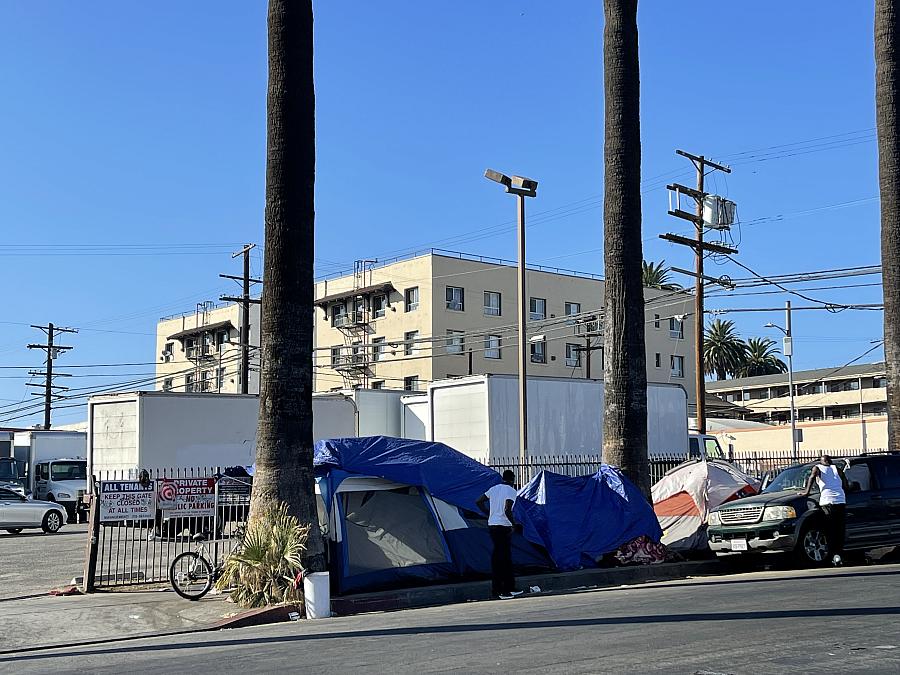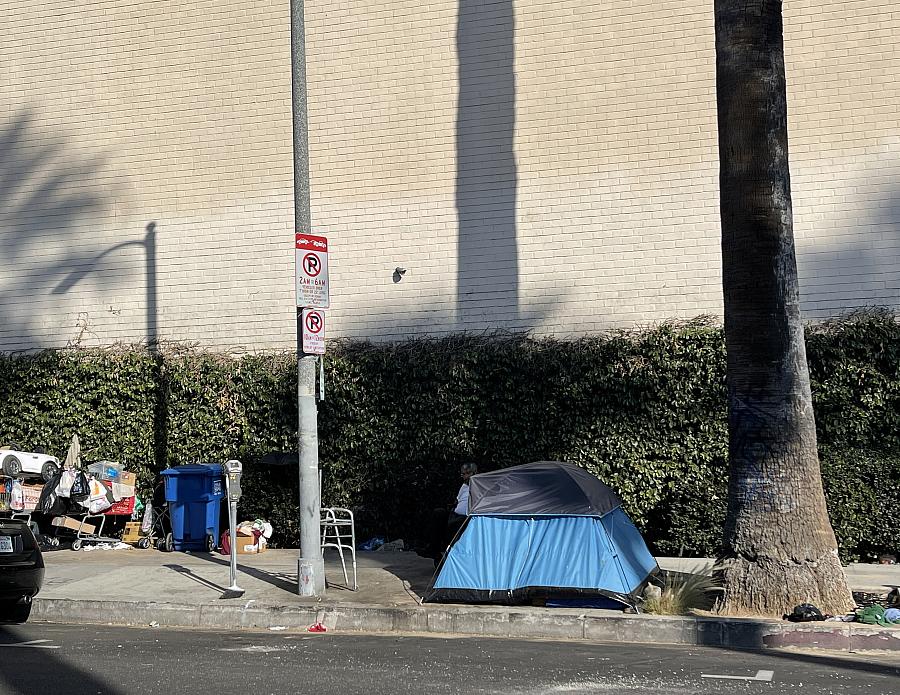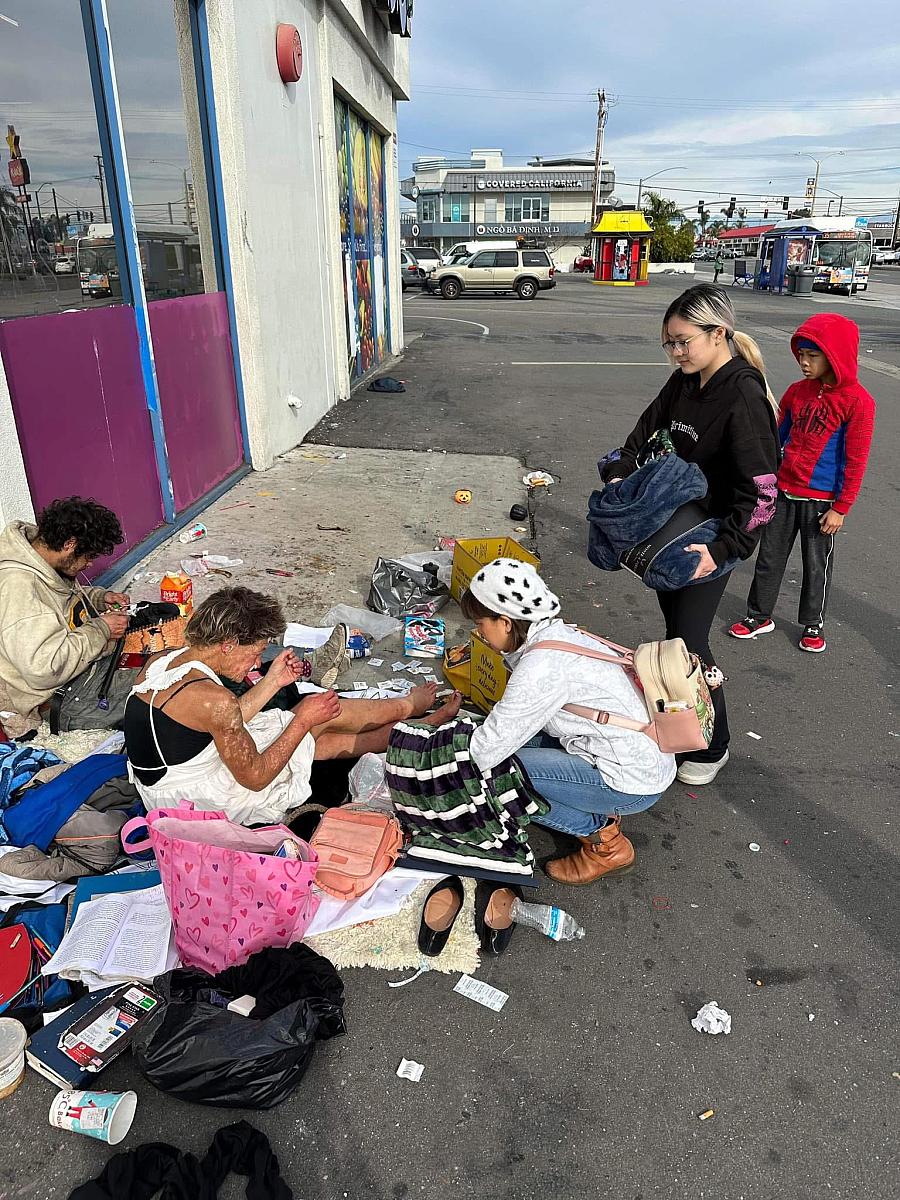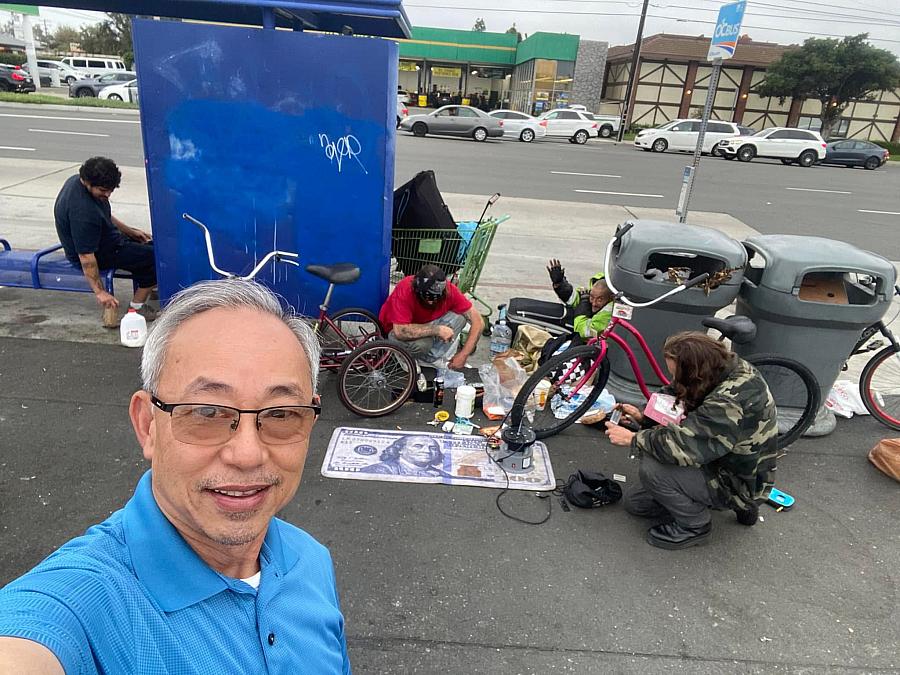Unaffordable Rents Driving Elderly Vietnamese in Little Saigon to Housing Instability and Homelessness
The story was co-published with Nguoi Viet Daily News as part of the 2025 Ethnic Media Collaborative, Healing California.

The corner near Bolsa and Weststate in Westminster where unhoused individuals gather in Little Saigon. (Photo: Nguoi Viet Daily News)
At a small corner near Bolsa and Weststate in Westminster, a frail woman gathers her courage to talk about her turbulent life, marked by family struggles and social hardship.
“I was homeless for seven or eight years,” said Lien Tran, 56, her voice trembling. “Now I stay with my son in a rented room behind ABC Supermarket (a Vietnamese grocery store), but I’m afraid of being a burden. That’s why I come out here every day to sit with my friends.”

According to an Orange County report, in the Little Saigon core, Westminster counted 288 people living unsheltered and Garden Grove had 239 residents experiencing homelessness in 2024. (Photo: Nhien Tra Nguyen)
Orange County counted 7,322 residents experiencing homelessness in its most recent federally required census, including 4,173 living without shelter, according to the county’s 2024 Point-in-Time (PIT) results.
In the Little Saigon core, Westminster counted 288 people living unsheltered and Garden Grove had 239 residents experiencing homelessness in 2024 – the latest countywide baseline used in 2025 reporting, according to the data from Orange County.
Health experts say homelessness creates a cycle of chronic stress that weakens the immune system and without stable housing chronic conditions become difficult to manage.
A life of upheaval
Lien came to the U.S. around 1991 under the Amerasian program. In the early years, she worked as a home care aide – living precariously but determined to raise her five children.
All of them are now adults, though one has a disability and relies on government assistance.
The Amerasian program was established under the Amerasian Immigration Act of 1982, signed into law on October 22, 1982. The act allowed individuals born in Vietnam, Korea, Laos, Cambodia, or Thailand between December 31, 1950, and October 22, 1982 — whose fathers were U.S. citizens — to apply for admission to the United States and obtain lawful permanent resident status.
“My husband of 19 years was taken by ICE three months ago while we were sleeping in our car,” she said tearfully. “They towed the car away, and all my documents – even my green card – were inside.”
Since her husband, Chinh Dao, was detained by Immigration and Customs Enforcement (ICE), the couple’s food stamps were cut off, leaving her unable to buy food for the family.
Taking a long drag from her cigarette, she continued through tears:
“I heard he’s still in detention, but I don’t have his number, and I don’t have money to send for him to call. I can only wait. I don’t even know how to read or write.”
Her husband now faces possible deportation to Vietnam or a third country.
The stress of her husband’s detention has taken a severe mental health toll on her.
It’s noon, and the sun grows hotter. A van carrying two Buddhist monks stops by and quietly hands a $20 bill to each of the three people sitting there – Lien and her two companions.
During the COVID-19 pandemic, Lien lost her home, her job and became homeless – drifting around the Garden Grove–Westminster area for years.
“I used to make a living by buying and reselling things, but it wasn’t enough. At one point, I even shoplifted just to feed my children,” she wept.
Lien is on MediCal and visits her doctor whenever she feels physically ill, though she doesn’t seek help for her stress and mental health symptoms. Research indicates that older Vietnamese adults consider mental health conditions to be closely tied to family or economic problems, and as such avoid admitting that they have an illness that might not be “real.”

The tent of unhoused individuals. (Photo: Nhien Tra Nguyen)
“I want to be free”
Sitting next to her is Xuan Truong, 65, who immigrated to the U.S. in 2013 under his daughter’s sponsorship.
“When I first came, I lived with my daughter for about seven or eight months,” he said. “But I felt cramped, so I moved out. I worked as a kitchen helper at Gia Hoi Restaurant for a few years. Still, it was tough, so I bought a van to sleep in.”
That van became both his home and only asset for nearly seven years before he had to sell it due to repair and living costs — leaving him homeless.
A Cal State Fullerton profile of Little Saigon found high rent burdens among local renters (majority paying >35% of income on rent), an older age profile, and below-county labor-force participation – factors that heighten homelessness risk even if not recorded as homelessness today.
“I have a 10-year green card. I really want to apply for citizenship, but I can’t read or write,” he said, wiping away tears.
Xuan Truong paid taxes in 2019 and 2020 and even received a tax return. But his health has declined in recent years — liver and intestinal issues require regular hospital visits, which are covered by MediCal.
During his years living in the van, he had to pay for access to a shower — starting at $50, later rising to $100 per month. Now, he rarely works and spends his days sitting and chatting with friends to ease his loneliness.
“I don’t want to go into a shelter or navigation center,” he explained. “It doesn’t feel comfortable. I prefer the freedom of being out here.”
Occasionally, his two daughters visit to give him pocket money and a new phone – though he often loses it.
“I don’t want to bother my kids,” he said quietly. “My sons-in-law think I’m renting somewhere. They don’t know I’m living on the streets.”
Over the past 11 years, he has applied for food stamps four times without success, Truong said.
Than Nguyen, a Community Engagement Supervisor of Orange County Social Services Agency (SSA) – the agency that issued CalFresh or food stamps – commented that there are many reasons for an individual to be denied the program.
“It could be the applicants cannot be reached for the interview appointment for CalFresh, they change the phone number so it does not match the record, or they did not provide the information we asked for…,” Than said.
“But if the applicants believed they were wrongly denied, they always have the right to appeal their case to SSA,” Than added.
“The good leaves protect tattered ones”

John Nguyen’s team delivered blankets to unhoused individuals in Little Saigon. (Photo: Courtesy of John Nguyen)
Sitting silently nearby is John Nguyen, who hands bottles of herbal tea to Lien and Xuan as they talk.
By day, John works as a graphic designer for a printing company. By night, he visits homeless encampments to chat and offer supplies like food, blankets, shampoo, and small essentials.

John Nguyen during a trip to assist the unhoused people in Little Saigon. (Photo: Courtesy of John Nguyen)
“When I first came to the U.S. in 1992, I also struggled and was homeless for a short time,” he said. “So, I understand what they’re going through.”
John began volunteering to help homeless individuals around 1993–1994 and has supported some for over 20 years.
“I’ve seen all kinds of people end up on the streets. Some struggle with mental health issues — not because they’re lazy or don’t want to work,” he said.
“The government doesn’t really address the right issue. They should focus more on mental health support. Giving money or housing alone won’t solve the problem.”
Asians composed about 3% of the county’s unsheltered count in the "point in time” (PIT) count, according to a “PIT” report published in May 2022.
Among the unsheltered population, more than 40% had substance abuse issues, and nearly 30% had mental-health issues.
Working to support homeless residents is Southland Integrated Services (SIS) — a nonprofit health center based in Garden Grove.
Oanh Nguyen, Community Support Case Manager at SIS, explained that the organization receives funding through CalOptima’s Community and Enhanced Care Management (ECM) program — which serves low-income residents of Orange County.
SIS helps homeless individuals or those at risk of homelessness find housing, pay for deposits and moving expenses, and stabilize once they move in.
“Only CalOptima members can access these services, and clients must be working to pay rent,” Oanh said. “If they’re unemployed, we refer them to the Day Habilitation program.”
The Day Habilitation program helps clients develop daily living skills needed to maintain stable housing.
She added that if a client has a history of drug use, the case manager can connect them to SIS’s in-house substance abuse counselor, or, for severe cases, refer them to county-level services.
“SIS also has funds that can help clients with car-related costs, such as vehicle registration,” she said.
As the afternoon light fades on the corner of Bolsa Avenue, the small circle of chairs empties out one by one. For people like Lien Tran and Xuan Truong, each day is a quiet struggle for dignity — to find shelter, to be seen, and to keep a fragile sense of belonging in the heart of Little Saigon.
Nearby, John Nguyen packs up the leftover drinks he brought to share. He knows his nightly visits won’t solve homelessness or heal all its wounds, but he keeps showing up anyway.
“What I do is just a drop in the ocean,” he said softly. “But even a drop can make a ripple – and maybe that ripple will reach someone who needs hope.”
This project was supported by the USC Annenberg Center for Health Journalism, and is part of “Healing California”, a yearlong reporting Ethnic Media Collaborative venture with print, online and broadcast outlets across California.
